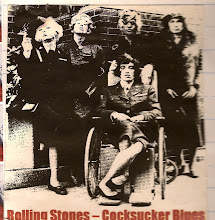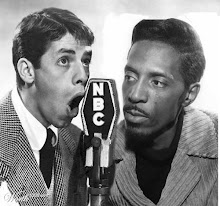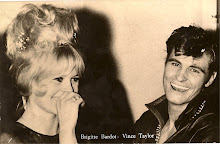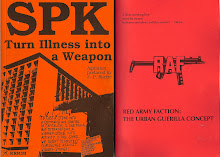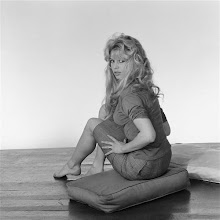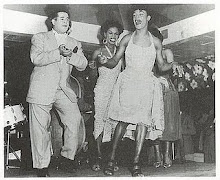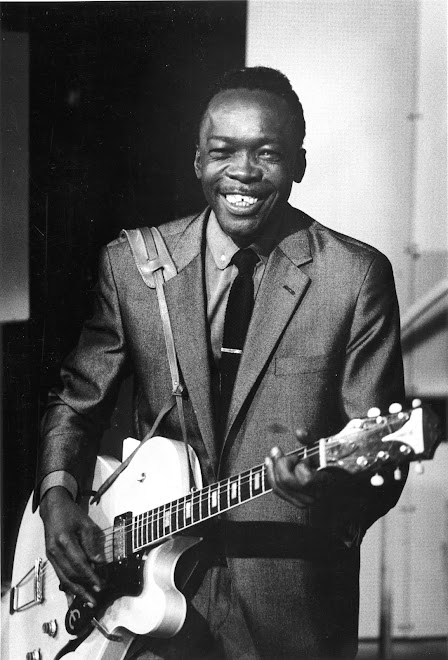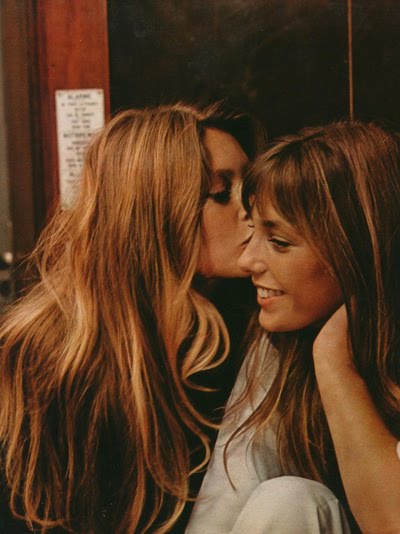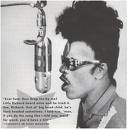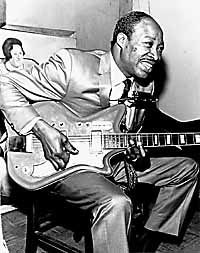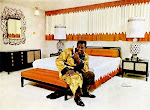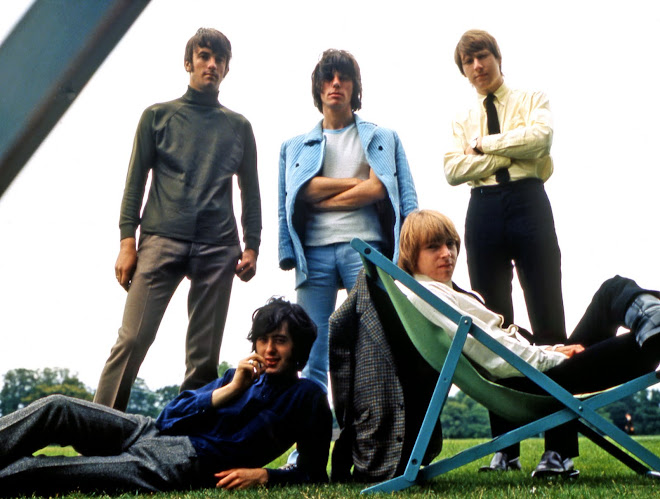2 hours ago
Monday, August 31, 2009
Ike Turner
I really love these clips of Ike Turner and a few of the Kings Of Rhythm.
For more on Ike, I did a post on him last year (here).
Thursday, August 27, 2009
James Luther Dickinson 2
 A Young Jim Dickinson (is this an Eggelston photo?)
Video for Down In Mississippi
Muscle Shoals, 1969, listening to the playback of Wild Horses, Dickinson is seated to Keith's left on the couch.
As an addendum to Aug. 18th's post concerning the death of Jim Dickinson, here is the JD & the Hoods version of Rumble issued by the Memphis based Barbarian Records in 1980. It's an amazing record, there's all sorts of stuff buried in the mix, and it takes the swagger of Link Wray's original version and adds a real Memphis feel to it.
It was already rare when I made my first visit to Memphis in 1981 and I've never been able to find a copy. This version was dubbed by Jim's son Luther of the North Mississippi All-Stars. The flip is a version of the old Freddie Slack/Ella Mae Morse tune House Of Blue lights which I've never heard. Barbarian also issued a Dickinson produced 45 by pro-wrestler Jerry Lawler, best known for giving Andy Kaufman a real life beating on the David Letterman Show. The Lawler record is a cover of the Jesters' Cadillac Man (Dickinson sang and played piano on the original Sun version).
A full Jim Dickinson discography can be found here. He also has a new CD out on the Memphis International label (his third) called Dinosaurs Run In Circles, which I haven't heard yet but am expecting in the mail any day. His other two MI discs-- Jungle Jim and the Voodoo Tiger (2006)
and Killers From Space (2007) are both excellent as is the 2002 Artemis release Free Beer Tomorrow which I think is still in print, or at least easy to find. Anyway,thanks to Luther Dickinson for the download of Rumble, it may be the only way you'll ever hear it.
MORE RIP'S: John Carter, lead singer of the Dells (and also the original lead singer of the Flamingos, on their early Chance and Vee Jay sides) passed away last week. Ellie Greenwhich, songwriter (usually with Jeff Barry) whose classics include Be My Baby, Leader Of The Pack, Hank Panky, and a thousand other classics went over the weekend.
A Young Jim Dickinson (is this an Eggelston photo?)
Video for Down In Mississippi
Muscle Shoals, 1969, listening to the playback of Wild Horses, Dickinson is seated to Keith's left on the couch.
As an addendum to Aug. 18th's post concerning the death of Jim Dickinson, here is the JD & the Hoods version of Rumble issued by the Memphis based Barbarian Records in 1980. It's an amazing record, there's all sorts of stuff buried in the mix, and it takes the swagger of Link Wray's original version and adds a real Memphis feel to it.
It was already rare when I made my first visit to Memphis in 1981 and I've never been able to find a copy. This version was dubbed by Jim's son Luther of the North Mississippi All-Stars. The flip is a version of the old Freddie Slack/Ella Mae Morse tune House Of Blue lights which I've never heard. Barbarian also issued a Dickinson produced 45 by pro-wrestler Jerry Lawler, best known for giving Andy Kaufman a real life beating on the David Letterman Show. The Lawler record is a cover of the Jesters' Cadillac Man (Dickinson sang and played piano on the original Sun version).
A full Jim Dickinson discography can be found here. He also has a new CD out on the Memphis International label (his third) called Dinosaurs Run In Circles, which I haven't heard yet but am expecting in the mail any day. His other two MI discs-- Jungle Jim and the Voodoo Tiger (2006)
and Killers From Space (2007) are both excellent as is the 2002 Artemis release Free Beer Tomorrow which I think is still in print, or at least easy to find. Anyway,thanks to Luther Dickinson for the download of Rumble, it may be the only way you'll ever hear it.
MORE RIP'S: John Carter, lead singer of the Dells (and also the original lead singer of the Flamingos, on their early Chance and Vee Jay sides) passed away last week. Ellie Greenwhich, songwriter (usually with Jeff Barry) whose classics include Be My Baby, Leader Of The Pack, Hank Panky, and a thousand other classics went over the weekend.
Wednesday, August 26, 2009
Gillian's Found Photo #23
 This week the Fang comes up with a photo from a collection of Polaroids taken at Stevensville Prison, which I think is in Maryland. Polaroids are popular in prisons, getting a good photo of yourself with a big time shot caller can be just the thing to let others know just who they're dealing with. These two? Just some righteous, meth tweakin', scooter ridin',
bad ass white folk, doin' their time. Either that or Three Dog Night got themselves locked up.
Outlaw pride indeed!
This week the Fang comes up with a photo from a collection of Polaroids taken at Stevensville Prison, which I think is in Maryland. Polaroids are popular in prisons, getting a good photo of yourself with a big time shot caller can be just the thing to let others know just who they're dealing with. These two? Just some righteous, meth tweakin', scooter ridin',
bad ass white folk, doin' their time. Either that or Three Dog Night got themselves locked up.
Outlaw pride indeed!
Tuesday, August 25, 2009
Why Blues Singers Should Be Named After Presidents....
I don't have anything to say today, except blues singers were better when they named 'em after presidents--- as seen above, we have Muddy Waters (McKinley Morganfield)
and Howlin' Wolf (Chester Arthur Burnett). If you plan on raising a blues singer, here's a good formula for naming the little bugger--- part one: a physical deformity or
handicap, part two: something to eat, part three: the name of a president. For example, Bowlegged Potato Carter. Or how about Ugly Pumpkin Adams. Anyway, the above clips are from the footage D.A. Pennebaker shot at the Newport Jazz Festival, I think the Muddy clip was '62 and the Wolf was shot in '66, but don't quote me on that, I'm too lazy to look 'em up. Just enjoy 'em.....
Monday, August 24, 2009
Larry Knechtel Dies
 Larry Knetchal 1940-2009
Larry Knetchal 1940-2009
 Kip Tyler- Will His Story Ever Be Told?
Studio keyboard player and bassist Larry Knetchal died of a heart attack last week. Knechtel was a member of LA's session players loosely known as the Wrecking Crew as well as a former member of Duane Eddy's Rebels and Kip Tyler and the Flips. He was born in Bell Garden, California in 1940. He also played on the Elvis '68 Comback (Singer Special) TV Show, played organ on the Beach Boys' Pet Sounds, played bass on the first Doors and Byrds albums (that's him on Mr. Tamborine Man). As the original members of the Flips die off (sax player Steve Douglas died in recent years)a great story is rapidly being lost to time, that is the story of Kip Tyler & the Flips. Still living members include Sandy Nelson, Jim Horn, Kip Tyler, Mike Bermani, Mike Deasy and Jimmy Troxel. Anyone out there got Kip's phone #?
Kip Tyler- Will His Story Ever Be Told?
Studio keyboard player and bassist Larry Knetchal died of a heart attack last week. Knechtel was a member of LA's session players loosely known as the Wrecking Crew as well as a former member of Duane Eddy's Rebels and Kip Tyler and the Flips. He was born in Bell Garden, California in 1940. He also played on the Elvis '68 Comback (Singer Special) TV Show, played organ on the Beach Boys' Pet Sounds, played bass on the first Doors and Byrds albums (that's him on Mr. Tamborine Man). As the original members of the Flips die off (sax player Steve Douglas died in recent years)a great story is rapidly being lost to time, that is the story of Kip Tyler & the Flips. Still living members include Sandy Nelson, Jim Horn, Kip Tyler, Mike Bermani, Mike Deasy and Jimmy Troxel. Anyone out there got Kip's phone #?
Saturday, August 22, 2009
Bobby Lee Trammell
 How come no one makes a scanner that fits a 12 x 12 LP?
How come no one makes a scanner that fits a 12 x 12 LP?
 Bobby Lee Trammell rocks out.
Bobby Lee Trammell rocks out.
 Bobby Lee Trammel, 1958.
Bobby Lee Trammel, 1958.


 Bobby Lee Trammell (b. Jan. 31, 1934) was crazy. Born in the country outside of Jonesboro, Arkansas, to a pair of cotton farmers (he father Wiley played fiddle, his mom Mae played organ in church, his little sister played on the linoleum) he had a typical upbringing of singing in church and listening to the Grand Ole Opry on the radio. The young Trammell had aspirations as a country singer, until one day, in 1956, a package tour hit Jonesboro, the headliners were Carl Perkins and Johnny Cash, and the ever affable Perkins allowed young Bobby to join his band onstage for a song, Perkins even recommended that Trammell try his luck in Memphis and talk to Sam Phillips. This Bobby Trammell did, only to be told to come back in a few weeks when Sam wasn't so busy. Not exactly the patient sort, Trammell headed for California where he landed in Long Beach and took a job in the Ford plant. He also found a gig singing at the Jubilee Ballroom in Baldwin Park. He attracted enough attention to get a record deal with the tiny Fabor label, run by Fabor Robinson. His first single-- Shirley Lee b/w I Sure Do Love You Baby was recorded using Bob Luman's group-- the Shadows as his backing band. The Shadows featured a young guitarist named James Burton who would soon leave Luman for the greener (as in money) pastures of Ricky Nelson's band (with whom he would re-cut Shirley Lee with Ricky Nelson on his second LP). Shirley Lee was a minor, regional hit. Fabor leased the master to ABC-Paramount, and it was off to the races for Bobby Lee Trammell. Unfortunately he placed out of the money.
Bobby Lee Trammell (b. Jan. 31, 1934) was crazy. Born in the country outside of Jonesboro, Arkansas, to a pair of cotton farmers (he father Wiley played fiddle, his mom Mae played organ in church, his little sister played on the linoleum) he had a typical upbringing of singing in church and listening to the Grand Ole Opry on the radio. The young Trammell had aspirations as a country singer, until one day, in 1956, a package tour hit Jonesboro, the headliners were Carl Perkins and Johnny Cash, and the ever affable Perkins allowed young Bobby to join his band onstage for a song, Perkins even recommended that Trammell try his luck in Memphis and talk to Sam Phillips. This Bobby Trammell did, only to be told to come back in a few weeks when Sam wasn't so busy. Not exactly the patient sort, Trammell headed for California where he landed in Long Beach and took a job in the Ford plant. He also found a gig singing at the Jubilee Ballroom in Baldwin Park. He attracted enough attention to get a record deal with the tiny Fabor label, run by Fabor Robinson. His first single-- Shirley Lee b/w I Sure Do Love You Baby was recorded using Bob Luman's group-- the Shadows as his backing band. The Shadows featured a young guitarist named James Burton who would soon leave Luman for the greener (as in money) pastures of Ricky Nelson's band (with whom he would re-cut Shirley Lee with Ricky Nelson on his second LP). Shirley Lee was a minor, regional hit. Fabor leased the master to ABC-Paramount, and it was off to the races for Bobby Lee Trammell. Unfortunately he placed out of the money.
In March of '58 Trammell cut his second single, this time Robinson issued it first on Fabor then re-issued it on the Radio subsidiary shortly after. Both sides are excellent--You Mostest Girl b/w Uh Oh, the a side being the more rocking of the two. So far, so good, and soon Bobby Lee Trammell was booked on the Louisiana Hayride, the regional radio show broadcast from Shreveport, Louisiana, where Elvis got his start. Unfortunately the Hayride hated him, booking agent Tillman Franks called him "downright vulgar" and "ten times worse than Elvis". His stint with the Hayride was cut short. When Farbor Robinson sold Trammell's contact to the Warrior label-- his next disc-- Woe Is Me b/w Open Up Your Heart was issued in 1959, rockabilly was not longer tearing up the charts back then but Trammell was not the type to give up easy. He returned to Arkansas and began recording for Terry Gordon's small group of label, highlights include Hi Ho Silver b/w Been A Walking (Vaden) in 1960, and a re-recorded version of You Mostest Girl that appeared on Skyla.
1961 saw two singles on the Alley label-- Arkansas Twist b/w It's All Your Fault
and Come On Baby b/w I Tried Not To Cry. The a side was a twist version of Arkansas Stomp, the b-side a Jimmy Reed style rocker. The second single featured a Chuck Berry type rocker on the top deck and a "crying" ballad (i.e., Bobby breaks down in sobs at the end) on the flip. Neither met which much success, even when Bobby took to climbing the tower of the radio stations that refused to play his records. Atlanta even issued an LP--Arkansas Twist.
At one point in Arkansas he destroyed Jerry Lee Lewis' piano which resulted in being black balled from the southern rock'n'roll touring circuit.
He kept cutting records, for smaller and smaller labels. 1962 saw a good one called - Sally Twist b/w Carolyn on Atlanta.
Rockabilly was way past its heyday but Trammel kept plugging, donning a Beatle wig he took to calling himself "the first American Beatle". Desperate for a hit, he cut some truly strange and wonderful discs-- Bobby Needs Love from the Arkansas Twist LP is an excellent What'd I Say style rocker. Toolie Froolie from '66 on the Hot label is a whacked out Surfin' Bird take off. The crazed New Dance In France was issued twice in 1966- first on Atlanta, then on Sims, both versions sunk without a trace, but a great record it is.
Bobby Lee Trammell kept plugging away, he cut country discs, including a remake of You Mostest Girl, then moved into an even sleazier branch of show business when he ran for and won a seat in the Arkansas State Senate. He developed a following in Europe among Teddy Boys and collectors and in the 80's he toured Europe where, ever the excitable performer he broke his wrist jumping on the piano (and missing). Back in the Arkansas, he served in the State Senate until 2002. At this point he'd given up singing, afraid it would ruin his career in politics.
He passed away on Feb. 20. 2008, in Jonesboro, his hometown.
Tuesday, August 18, 2009
James Luther Dickinson
 James Luther ("Jim") Dickinson died last Saturday (Aug. 15) of a heart attack. His loss to the world of rock'n'roll cannot be understated. He was one of a kind. The good kind.
James Luther ("Jim") Dickinson died last Saturday (Aug. 15) of a heart attack. His loss to the world of rock'n'roll cannot be understated. He was one of a kind. The good kind. He was born in the countryside outside of Memphis where he moved as a tyke. His father was a repair man and once he followed his father into a studio where Howlin' Wolf was doing a radio broadcast. Needless to say, this was a life changing moment. He played piano in dozens of teenage bands, put in a season at Baylor college then returned to Memphis to work as a studio musicians for Bill "Raunchy" Justis, for whom he cut his first single, a quasi- jug band thing called You Do It All The Time.
He sang on the Jesters' Sun classic-- Cadillac Man b/w My Babe the last good Sun 45 (even though he wasn't even in the band). Another early killer 45 appeared on the Southtown label-- issued as by Jim Dickinson & the Katmandu Quartet, one side was a an organ driven frat party raver-- Monkey Man, the flip,a blues shuffle called Shake 'Em On Down (1966). A good start in the biz if there ever was one, he was batting 1000%.
In Memphis he worked as session piano player, put together various bands, got into production, and ended up as a member of the Dixie Flyers, the rhythm section put together by Jerry Wexler to replace the Muscle Shoals players whom he'd had a falling out with. With the Flyers, relocated to Miami, he played with Aretha (Spirit In The Dark), Wilson Pickett, Duane Allman, even put in an appearance on the Flamin' Groovies Teenage Head (Kamu Sutra), all this as well as recording a killer solo LP-- Dixie Fried (Atlantic, 1970) from which Wine, and Louise, are highlights (I'd post the whole LP but it seems to get pulled down whenever it's posted). Another great record is Flash and the Memphis Casuals, a great garage rocker that Dickinson appeared on in ' 67--- Uptight Tonight.
In the 70's he formed a group called Mudboy & the Nuetrons, who made three great LP-'s-- Known Felons In Drag (New Rose, 1986), Negro Streets At Dawn (New Rose, 1993) and They Walk Among Us (New Rose 1995). My favorite cuts are Codine, I Can't Feel At Home Anymore, Power To The People, I've Got A Secret (Shake Sugaree). The other band members included Lee Baker, Sid Selvidge, and Jimmy Crosswaite. All three LP's are worth hunting down.
Dickinson stayed busy as a producer-- working with the Replacements, Mudhoney, Big Star, the Panther Burns and his sons' band-- the North Mississippi All Stars.
Another great record Jim Dickinson steals the show on is the Johnny Burnette Trio re-union LP, issued in the early 80's on Paul Burlison's Rockabilly label (the Burnettes were all ready dead), but Dickinson appears with Burlison, Eddie Bond, James Van Eaton, Johnny Black and others, and his two tracks-- Rooster Blues and Ubangi Stomp are killers. He also cut a one off backed by the Cramps which appeared on a Big Big (U.K.) sampler, where he tears through Red Headed Woman like there's no tomorrow.
He played piano in Ry Cooder's band (and on the Stones' Wild Horses, Ian Stewart couldn't play in minor keys)
As a producer he produced the best Alex Chilton LP's (Like Flies On Sherbett), Big Star (Sister Lovers), not to mention hits by the Replacements and Mudhoney. After nearly thirty years since Dixie Fried he returned to the studio to record two excellent LP's--
Free Beer Tomorrow and Jungle Jim and the Voodoo Tiger (both Memphis International)
As a bar owner one of my proudest moments was having Jim Dickinson appear at the Lakeside Lounge with a band that featured my partner Eric "Roscoe" Ambel on guitar.
One of the best shows I ever saw, I wish I had a tape. I think it was his New York debut (I can't remember the year, 2003?), Oddly enough his sons the North Mississippi All-Stars made their NYC debut at the Lakeside also.
Dickinson also did some field recording around Memphis, three volumes of these sounds-- Beale St Saturday Night (Memphis Development Foundation) for years was available only at the drug store on Beale St., two volumes of Delta Experimental Projects Compilation: Down Home (New Rose) later appeared in the 80's and are well worth hunting down. Another killer 45 issued in '77 on the Barbarian label under the guise of JD & the Hoods-- Rumble is one I've been looking for for ages, anyone got one to sell or trade?
Dickinson was something of a musical philosopher, see the interview above. He never minced words. On Chuck Levall, the Stone long time piano player-- "that cocktail lounge playing mother fucker....". He never got to produced Dylan or the Stones, the two acts that needed him most.
Such is life. I suggest you get yourself a copy of Dixie Fried (Atlantic), and Known Felons In Drag (New Rose), sit back and and enjoy what was one of America's last great rock'n'roll characters.
We won't see the likes of him again.
Thursday, August 13, 2009
Les Paul
 Les Paul died yesterday, age 94. It seems for as long as I remember he held down a Monday night gig someplace in NYC, I saw him many times, he was always great. I love his old Capitol records with Mary Ford, they sound like they were recorded in outer space. I thought as a tribute I'd thrown in a couple of long excerpts from their 50's radios show (here and here),
they're quite amusing. I'm sure there'll be obits in every paper and magazine in America, I don't need to go into his history here, but take a listen to those airchecks, they're a hoot.
Les Paul died yesterday, age 94. It seems for as long as I remember he held down a Monday night gig someplace in NYC, I saw him many times, he was always great. I love his old Capitol records with Mary Ford, they sound like they were recorded in outer space. I thought as a tribute I'd thrown in a couple of long excerpts from their 50's radios show (here and here),
they're quite amusing. I'm sure there'll be obits in every paper and magazine in America, I don't need to go into his history here, but take a listen to those airchecks, they're a hoot.
Tuesday, August 11, 2009
Gillian's Found Photo #22
 It's July '57 and according to the scribble on the back of this photo it's Elvis Presley night at the Variety Show at Kingsway, so says David, whoever that is. Can anyone identify the hot boppin' hepcat in the white bucks? Did he cut any records? There's something familiar looking about this guy. The piano player seems lost, is he about to sit down and start playing? Can the audience hear the unamplified guitars? Who knows, but the Fang surely came up with a good photo this week, no?
It's July '57 and according to the scribble on the back of this photo it's Elvis Presley night at the Variety Show at Kingsway, so says David, whoever that is. Can anyone identify the hot boppin' hepcat in the white bucks? Did he cut any records? There's something familiar looking about this guy. The piano player seems lost, is he about to sit down and start playing? Can the audience hear the unamplified guitars? Who knows, but the Fang surely came up with a good photo this week, no?
Monday, August 10, 2009
It's A Nugget If You Dug It....
I've always loved the Music Machine's Talk Talk, dig those get ups!
From the TAMI Show, the Barbarians featuring Moulty.
The Count Five's Psychotic Reaction- When this came out we thought it was a new Yardbirds record....
The Preachers version of Who Do You Love, I heard this on the radio exactly once.
The 13th Floor Elevators' You're Gonna Miss Me, a huge hit where I grew up in S. Florida.
In 1972 Lenny Kaye compiled the Nuggets compilation for Elecktra Records, it was subtitled "Artifacts from the first psychedelic era", but the music was soon dubbed punk rock, probably by Greg Shaw, although Dave Marsh seems to think it's important for the world to know that he coined the term. Actually the first use of "punk" in music writing was by Nick Tosches who described Ed Sanders of the Fugs as having a "punk muse". No matter, the sound of these one-hit, teenage American bands was soon changed from punk rock to garage rock to distinguish it from the safety pin through the face variety of 70's punk. What I find so interesting is Lenny Kaye's vision in excavating the past. The music was only six years old (using 1966 as the banner year for American garage), yet Kaye understood it's importance at a time when most rock writers were busy analysing Bob Dylan's lyrics (or digging through his trash), or heralding the coming revolution, which was to be led by the Jefferson Airplane or Abbie Hoffman or whom ever. Only two of the above tracks made it onto Nuggets (Talk Talk was short listed but was unavailable due to legal problems, the Barbarians were represented by the song Moulty, not their best record, but surely a first class "artifact"). The Preachers track appeared on the first Pebbles album (Greg Shaw's bootleg continuation of the Nuggets concept). There was something in the air, for that same year, Mark Shipper released the first Sonics re-issue Explosive (Buckshot), sold through an ad in Who Put The Bomp fanzine. This was followed by the aforementioned Pebbles series which kicked off in 1976 and opened a floodgate. Soon every collector of garage 45's had their own compilation album on the market. My favorites: Hipsville 29 B.C., three volumes (Kramden), What A Way To Die (Satan), Open Up Yer Door (Frog Death) Off The Wall, two volumes, (Wreckord Wracked) The Chosen Few, two volumes (A-Go Go) and of course Back From The Grave nine volumes (Crypt), which was legally done unlike the others which were bootlegs. All of these can be downloaded from various blogs, try looking via Chewbone or Captain's Crawl (new URL). Soon there would be similar comps by every style, region, and/or label configuration possible, sometimes it seems like there were more comps than their were original 45's. The Droogs issued their first 45-- He's Waitin' b/w Light Bulb Blues (Plug'n'Socket), the first "new" group to revive the sound of '66. By the mid-70's more bands appeared like the Fleshtones, DMZ and the Chesterfield Kings to play much in the style of these (not very) old records. This caused much confusion as to what "punk" was or should be. I bring this up because the world seemed so much bigger and more mysterious back then, when everything hadn't been re-issued. The fans themselves were able to grasp control of the music for the first time ever. It really did change history.
Garage rock is a genuine marketing term nowadays, and nothing seems very special at all. In fact garge rock had little to do with Lenny's original concept for Nuggets, he wanted each new volume to cover a different musical style (ie--a girl group Nuggets, a surf Nuggets, etc.) but alas, Nuggets lasted only one volume (although Rhino revived the title for two box sets, one of US and one of UK era sides).
I don't listen to this type of music much in my old age, but it's fun to see these videos, and to pull out the records once and awhile. It's a Nugget if you dug it.
Friday, August 7, 2009
David Marks- The Forgotten Beach Boy
 The Beach Boys say goodbye to David Marks, 1963...
The Beach Boys say goodbye to David Marks, 1963...Playing rhythm guitar is a noble but unglamorous job. But even for such an unheralded job, David Marks, one of rock'n'roll's greatest rhythm guitarists, has been given an unfair pass by history. David Marks, the rhythm guitar player in the Beach Boys from 1961-3 has always fascinated me since he was basically written out of history. The Beach Boys always kept tight control over their image and legacy (in fact, the best book on the Beach Boys-- David Leaf's The Beach Boys and The California Myth has been out of print almost since it's first printing, and it's author hired by the Beach Boys, probably to shut him up). The official Beach Boys party line is the Marks replaced Al Jardine for a few months when Jardine returned to school, in reality Marks was in the group for nearly three years, joining the band shortly after their first single--Surfin' for the tiny Candix (later X) label, joining in time to play on Surfin' U.S.A. ,he was on all their early tours and first four LP's, his last session was Be True To Your School b/w In My Room.
David Marks, whose family moved from Pennsylvania to Hawthorne, California was the across the street neighbor of the Wilson family, he learned to play guitar along side Carl Wilson (taking lessons together from the same instructor) and ran with Dennis from the time he was eight years old.
Marks too has a book--- The Lost Beach Boy (David Marks with Jon Stebbins, Virgin Books, 2007), an incredible read and probably the best bird's eye view of the early Beach Boys we shall ever see. Marks' tale is often riveting, more often hilarious-- where else can you read of the Beach Boys' first trip to the whorehouse? Or their first experience with the clap? The stories of Dennis' Wilson's wild and woolly ways are alone worth the cover price. Already nuts, and when rock stardom kicked in at age 17 Dennis went totally bonkers (as drummers will do), but I don't think we'll get a closer or more honest look at the young Dennis Wilson than the one Marks paints.
The Lost Beach Boy is quite candid, from page 92 a letter from the road Marks never mailed:
Dear Mom and Dad,I'm having a fucking great time on the road! We're drinking lots of whiskey and screwing whores in every town. My dick is oozing green pus but don't worry, we're all getting penicillin shots soon. I can't wait to tell you about the rest of the things we've done. See you in a week!Love, David
The first part of the book which deals with his years as a Beach Boy and what happens when you take a bunch of teenagers and give 'em a hit record (they go ape shit) is the most interesting. Marks quit the band in 1963, at the peak of their fame, after a fight with Murray Wilson, who had been trying to force him out of the band all along . Of course Murray comes off as the bad guy, he's virtually impossible to defend, but Murray Wilson is also a lot of fun to read about, as any Beach Boys fan knows. You just can't have too many 'crazy Murray' stories for me. Brian come off as the hardest to pin down, and Marks was in such awe of his talent he never really gets close to him. Carl comes off like a nice, fat, kid, Mike Love an unexpected decent guy, and Marks himself caught in a dream he didn't quite understand. He left the Beach Boys convinced he could pull it off solo-- in fact he made some pretty good sides doing biz as David Marks and the Marksmen, including a couple of killer surf instrumentals-- Sheriff of Noddingham (a dope reference?) and Travelin' are excellent surf instrumental sides, and I love the snot nose rocker Crusin'. I also like his version of Chris Montez' Let's Dance, and the goofy, Beach Boys-esque (ish?)-- Kustom Kar Show. For perversity's sake I thought I'd throw in this one as I can't imagine anyone really thought a Food Fair would be the next big craze after Surfin', which it wasn't but didn't stop Marks from releasing it as a single. As good as these sides were, David Marks was simply not in the same league as Brian Wilson (who was?), and the idea that he could compete with his ex-band mates does show a hint of unreality. The fact that his first single (Cruisin' b/w Kustom Kar Show) was released just as the Beatles began their usurpation of American pop music didn't help matters at all.
Upon leaving the Beach Boys, David Marks was simply written out of their history. Al Jardine? He was only gone for a couple of months according to the new official party line. Just had to finish his schooling! In truth Jardine had only been in the group for a couple of months, and was gone for nearly three years. You will not find the truth in any official account of the Beach Boys story, come to think of it, even the non-official versions have given Marks' the short shrift.
After David Marks and the Marksmen broke up, Marks formed the psychedelic group Moon, whom some folks love (me, not so much), a short stint in A Band With No Name (funded by Casey Kasem) and eventually went back to music school at Berklee in Boston. Of couse, he spent a lost decade in an alcohol and drug induced haze emerging with the dreaded Hep C, and finally rejoining the Beach Boys occasionally, starting in the early 90's and into the Wilson-less years, where only he, Mike Love and Bruce Johnston (who still has never become a full fledged voting member of the band, after forty five years in the group) where the only Beach Boys on a stage full of people. Even Al Jardine was eventually booted out in the mid-nineties, and one would assume Mike Love was desperate for some "authentic" Beach Boys to fill out the stage.
Marks and Carl Wilson might've been goofy teenagers but they were a great and highly under rated guitar team, as the first four Beach Boys LP's prove, and Marks' story is a must read for any hardcore Beach Boys fan. It might be the only believable account of their earliest days. From terrorizing their Hawthorne neighbors (with Dennis as the natural born leader of the gang) to morphing into a great rock'n'roll band under Brian's tutelage, this book is the best inside account yet written. The second part of the book of course deals with Marks' hard landing back into the world, no longer a teenage star, in fact practially unknown, and involved in an ugly battle with Murray Wilson who used his considerable power to sabatoge Marks' career whenever possible. This too is interesting reading, if a somewhat familar sounding story. Oddly enough, in these wilderness years, Mike Love again comes to Marks' rescue, more than once!
Yes, playing rhythm guitar is indeed a noble occupation. A great rhythm guitar player should leave well enough along, too many rhythm guitar players have destroyed themselves attempting to show the world they can do more than "just play rhythm"--
David Crosby (great in the Byrds, worthless in every other way) and Brian Jones both come to mind, you can add David Marks to that list.
Thursday, August 6, 2009
The Yardbirds
For your, well actually, my viewing pleasure I present Yardbirds footage that either I've never seen before (from European TV) or haven't seen since I was a tyke. I got bored today and put Yardbirds into the YouTube search box and sure enough there's some new stuff since I last checked about a year ago. I love the Yardbirds and assume most of you do too. So much has been written about the Yardbirds over the years that I have little to add, except that I still listen to them constantly.
It's been a longstanding love affair, after buying the 45 of Heart Full Of Soul b/w Steeled Blues (I didn't really like their first U.S. hit For Your Love), I managed to acquire their first two LP's-- For Your Love and Having A Raving Up With The Yardbirds in 1966, having traded a copy of Beatles '65 with a neighbor. I still think I got the best of the deal. I was seven years old and I can distinctly remember being aware of how the sound of the guitar was changing-- from the Kinks' "You Really Got Me" to the Stones' "The Last Time" and then the first side of Having A Rave-Up (in my opinion the peak of Jeff Beck's style), the guitar was becoming a rather ominous sounding instrument (of course I was unaware at that time of earlier purveyors of guitar noise like Link Wray and Johnny Guitar Watson). I eventually bought every single second of music the Yardbirds have ever recorded and still get excited when anything new surfaces, especially from the Beck period (Aug. '65-- Oct. '66).
Louise (bottom) is the only footage I've ever seen with Clapton on guitar (my least favorite of the three). There's an interesting version of My Gal Sloopy and I Wish You Would that I've never seen, unfortunately the embedding has been disabled so I can't run it here, but you can catch it here, it looks like Jim McCarty himself provided the footage. The CD re-issues of For Your Love, Having A Rave-Up and Over Under Sideways Down, along with non-LP' singles, bonus tracks and outtakes are essential.
Wednesday, August 5, 2009
Gillian's Found Photo #21
 Not exactly a found photo this week, more like a donated pic we just love. The photographer is the famed Kate Simon, and the subject is the spawn of U.K. glam rock
Not exactly a found photo this week, more like a donated pic we just love. The photographer is the famed Kate Simon, and the subject is the spawn of U.K. glam rockAlvin Stardust, about whom I know almost nothing and don't think I've ever heard, except for when he was Shane Fenton and make a record called I'm A Moody Guy which wasn't half bad, still isn't. Anyway, there's something truly off about this little duffer. I wonder what he's doing these days?
Saturday, August 1, 2009
Johnnie Ray- The Little White Queer That Cried

 Johnnie Ray in a rather peculiar publicity photo.
Johnnie Ray in a rather peculiar publicity photo.
 Detail from 10 Inch LP That Doesn't Quite Fit In My Scanner
Early TV Appearence
Johnnie Ray and Fats Domino-- What Did They Have In Common?
He was not the first white man to attempt to sound black, nor was he the first man to sing like a woman. Johnnie Ray (b. John Alvin Ray, 1927 in Dallas, Oregon) was, however, the first white man to sing like a black woman and top the charts. As far as pop stars go, he was a strange creature, an abomination of sorts. And his story is worth retelling one more time.
The first real excitement that found our hero was a savage game of blanket toss that left Ray deaf at the age of nine. Until a hearing aid was fitted to his concha, his teachers considered him retarded.
In this manner he passed through high school, a young man of little promise. Upon reaching his majority, Ray headed for Hollywood-- following in the footsteps of so many worthless others-- he would be in pictures and show the folks back home that he was no spazz.
Hollywood, however, had little use for the challenged young man and Ray soon abandoned his hopes for the silver screen and set his sights on a career in music. No mean trick for a deaf kid. No matter how loud he turned up his hearing aid, he could not hear the bass player, which made singing in time a great struggle. He did, however, play a little piano-- and inspired by the tortured instrument that was Billie Holiday's voice and R&B crooners like Ivory Joe Hunter, Little Jimmy Scott and Dinah Washington -- he forged his own style. By 1951, after being run out of clubs everywhere for being too weird, Ray found an appreciative audience in Detroit at the Flame Show Bar, the best sepia room in town (Jackie Wilson and Lavern Baker were both discovered there, the latter doing biz as "Little Miss Sharecropper"). Johnnie Ray played piano and crooned ballads between sets by Maurice King's Wolverines (King would go on to a job at Motown, teaching young acts how to shave their armpits and to not belch in public).
It was at the Flame that Danny Kessler, president of Okeh Records, Columbia's newly reactivated R&B wing, discovered Ray, inking him to a record deal and recording him with King's band. Johnnie Ray's first disc, a spare, bluesy, original titled Whiskey and Gin was released in August, 1951 on the purple and gold Okeh label. Billboard's astute reviewer called Ray's voice "a cross between Kay Star and Jimmy Scott". When Whiskey and Gin sold well in R&B markets and with teenage girls, Columbia's prexy Mitch Miller took interest and signed himself on as Ray's producer. His first matter of biz was to match Ray with the song Cry.
Cry had gone nowhere when it was originally recorded by Ruth Casey for the obscure Cadillac label. Ray took the song and working out a head arrangement with studio musicians and the vocal group the Four Lads-- rewrote it into an emotion filled plea. Stretching syllables ridiculously, his voice reached into a choking upper register that bordered on a whine. It was either moving or pathetic, depending on your stand, but with Cry, Johnnie Ray had stuck paydirt.
Cry went to #1 on both the pop and R&B charts where it stayed for eleven weeks in the fall of 1951. There was something in the sound of Ray's whimper that roused women to seismic enthusiasm. This unlikely pop idol-- gangly, effete and adorned with a clumsy hearing aid was met at the airport in Cleveland by 5,000 screaming girls who tore the clothes from his limbs. The successor to Sinatra, and the precursor to Elvis had arrived. He started wearing cheap suits rather than lose the good ones to the paws of howling teenage girls.
Although the flipside of Cry, an original tune called The Little White Cloud That Cried also climbed the charts to peak at #2, Ray's freakishness soon ignited a controversy that overshadowed his music. Ava Gardner was said to be obsessed with Ray, leading to a punch in the snout from pseudo-tough guy Frank Sinatra. As a gay man he was subjected to many degrading exposes, such as can be found in early 50's issues of the vile and fascinating Confidential magazine which ran feature stories like "Is It True What They Say About Johnnie Ray?", "Why Johnnie Ray Likes To Go In Drag" and "When Johnnie Ray Was Noel Coward's House Guest". There was an "incident" in a public toilet, one critic claimed the hearing aid was a gimmick. The hoopla hurt Ray, yet through it all he remained childlike and amazed, almost innocent, often self deprecating: "I never considered myself a singer. I classify myself as a song stylist, a performer, an actor...you're either pro-Johnnie Ray or you hate my guts". He was kicked upstairs to Okeh's parent label Columbia, alongside Sinatra and Tony Bennett and the hits kept coming-- Please Mr. Sun, Walking My Baby Home, R&B tunes like Clyde McPhatter's Such A Night, Joe Turner's Flip Flop and Fly, and the Prisonaires' Just Walkin' In The Rain. Also in his catalog are some oddball items with a distinct pre-rock'n'roll feel-- Oooh! Aaah! Oh! and the bluesy I Want To Be Loved should be singled out.
During these gravy years, Johnnie Ray made many TV and movie appearances, worked the best clubs and concert halls, hid from nosy reporters (often in Spain) and eventually the success waned, helped along by the ugly rumors and the bad publicity.
One of his most loyal audiences was found in England, where he appeared many times at the London, Palladium, even recording a live (ten inch) LP there, a record which gives us an idea of the hysteria created both by Ray onstage and by the Ray-worshipping audience. From that LP I present his rousing set opener Please Don't Talk About Me When I'm Gone, the overboard Glad Rag Doll, a hysterical reading of Such A Night and the big finale of Little White Cloud That Cried/I'm Gonna Walk and Talk With My Lord. Listen to that crowd!
Soon Elvis arrived and eclipsed even the controversy, and Johnnie Ray returned to the bars and lounges, making a comfortable living crying all over his piano. They still came, the little girls, now old and fat, wearing stretch pants and girdles. They came and they cried along with Johnnie Ray. Through the psychedelic 60's, the leisure suit 70's and the greed worshipping 80's, they still came out-- Johnnie's fans never let him down. They filled the rooms, put bread on the table and wine in the jug. It was the jug that did him in. On February 24, 1990, Johnnie Ray's liver packed it in, and the little white queer cried no more.
Detail from 10 Inch LP That Doesn't Quite Fit In My Scanner
Early TV Appearence
Johnnie Ray and Fats Domino-- What Did They Have In Common?
He was not the first white man to attempt to sound black, nor was he the first man to sing like a woman. Johnnie Ray (b. John Alvin Ray, 1927 in Dallas, Oregon) was, however, the first white man to sing like a black woman and top the charts. As far as pop stars go, he was a strange creature, an abomination of sorts. And his story is worth retelling one more time.
The first real excitement that found our hero was a savage game of blanket toss that left Ray deaf at the age of nine. Until a hearing aid was fitted to his concha, his teachers considered him retarded.
In this manner he passed through high school, a young man of little promise. Upon reaching his majority, Ray headed for Hollywood-- following in the footsteps of so many worthless others-- he would be in pictures and show the folks back home that he was no spazz.
Hollywood, however, had little use for the challenged young man and Ray soon abandoned his hopes for the silver screen and set his sights on a career in music. No mean trick for a deaf kid. No matter how loud he turned up his hearing aid, he could not hear the bass player, which made singing in time a great struggle. He did, however, play a little piano-- and inspired by the tortured instrument that was Billie Holiday's voice and R&B crooners like Ivory Joe Hunter, Little Jimmy Scott and Dinah Washington -- he forged his own style. By 1951, after being run out of clubs everywhere for being too weird, Ray found an appreciative audience in Detroit at the Flame Show Bar, the best sepia room in town (Jackie Wilson and Lavern Baker were both discovered there, the latter doing biz as "Little Miss Sharecropper"). Johnnie Ray played piano and crooned ballads between sets by Maurice King's Wolverines (King would go on to a job at Motown, teaching young acts how to shave their armpits and to not belch in public).
It was at the Flame that Danny Kessler, president of Okeh Records, Columbia's newly reactivated R&B wing, discovered Ray, inking him to a record deal and recording him with King's band. Johnnie Ray's first disc, a spare, bluesy, original titled Whiskey and Gin was released in August, 1951 on the purple and gold Okeh label. Billboard's astute reviewer called Ray's voice "a cross between Kay Star and Jimmy Scott". When Whiskey and Gin sold well in R&B markets and with teenage girls, Columbia's prexy Mitch Miller took interest and signed himself on as Ray's producer. His first matter of biz was to match Ray with the song Cry.
Cry had gone nowhere when it was originally recorded by Ruth Casey for the obscure Cadillac label. Ray took the song and working out a head arrangement with studio musicians and the vocal group the Four Lads-- rewrote it into an emotion filled plea. Stretching syllables ridiculously, his voice reached into a choking upper register that bordered on a whine. It was either moving or pathetic, depending on your stand, but with Cry, Johnnie Ray had stuck paydirt.
Cry went to #1 on both the pop and R&B charts where it stayed for eleven weeks in the fall of 1951. There was something in the sound of Ray's whimper that roused women to seismic enthusiasm. This unlikely pop idol-- gangly, effete and adorned with a clumsy hearing aid was met at the airport in Cleveland by 5,000 screaming girls who tore the clothes from his limbs. The successor to Sinatra, and the precursor to Elvis had arrived. He started wearing cheap suits rather than lose the good ones to the paws of howling teenage girls.
Although the flipside of Cry, an original tune called The Little White Cloud That Cried also climbed the charts to peak at #2, Ray's freakishness soon ignited a controversy that overshadowed his music. Ava Gardner was said to be obsessed with Ray, leading to a punch in the snout from pseudo-tough guy Frank Sinatra. As a gay man he was subjected to many degrading exposes, such as can be found in early 50's issues of the vile and fascinating Confidential magazine which ran feature stories like "Is It True What They Say About Johnnie Ray?", "Why Johnnie Ray Likes To Go In Drag" and "When Johnnie Ray Was Noel Coward's House Guest". There was an "incident" in a public toilet, one critic claimed the hearing aid was a gimmick. The hoopla hurt Ray, yet through it all he remained childlike and amazed, almost innocent, often self deprecating: "I never considered myself a singer. I classify myself as a song stylist, a performer, an actor...you're either pro-Johnnie Ray or you hate my guts". He was kicked upstairs to Okeh's parent label Columbia, alongside Sinatra and Tony Bennett and the hits kept coming-- Please Mr. Sun, Walking My Baby Home, R&B tunes like Clyde McPhatter's Such A Night, Joe Turner's Flip Flop and Fly, and the Prisonaires' Just Walkin' In The Rain. Also in his catalog are some oddball items with a distinct pre-rock'n'roll feel-- Oooh! Aaah! Oh! and the bluesy I Want To Be Loved should be singled out.
During these gravy years, Johnnie Ray made many TV and movie appearances, worked the best clubs and concert halls, hid from nosy reporters (often in Spain) and eventually the success waned, helped along by the ugly rumors and the bad publicity.
One of his most loyal audiences was found in England, where he appeared many times at the London, Palladium, even recording a live (ten inch) LP there, a record which gives us an idea of the hysteria created both by Ray onstage and by the Ray-worshipping audience. From that LP I present his rousing set opener Please Don't Talk About Me When I'm Gone, the overboard Glad Rag Doll, a hysterical reading of Such A Night and the big finale of Little White Cloud That Cried/I'm Gonna Walk and Talk With My Lord. Listen to that crowd!
Soon Elvis arrived and eclipsed even the controversy, and Johnnie Ray returned to the bars and lounges, making a comfortable living crying all over his piano. They still came, the little girls, now old and fat, wearing stretch pants and girdles. They came and they cried along with Johnnie Ray. Through the psychedelic 60's, the leisure suit 70's and the greed worshipping 80's, they still came out-- Johnnie's fans never let him down. They filled the rooms, put bread on the table and wine in the jug. It was the jug that did him in. On February 24, 1990, Johnnie Ray's liver packed it in, and the little white queer cried no more.
Subscribe to:
Posts (Atom)
Let's Hear It For The Orchestra
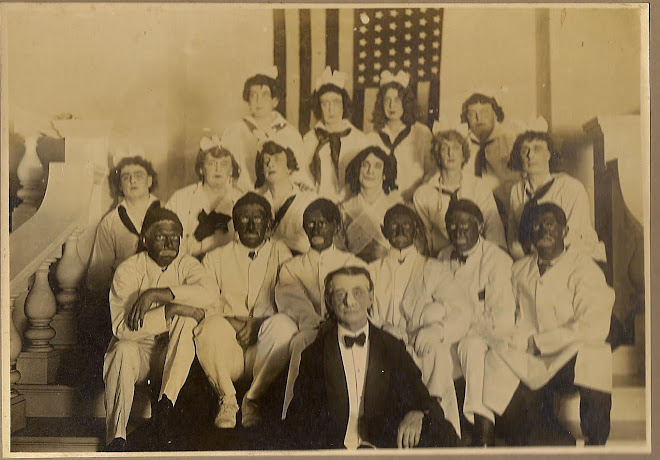
copyright Hound Archive



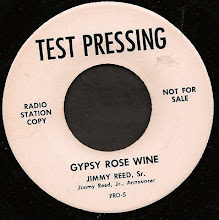
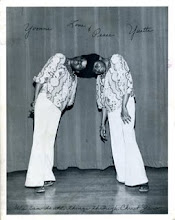


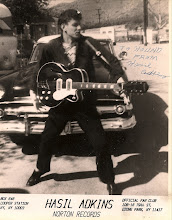


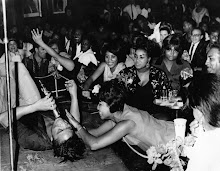

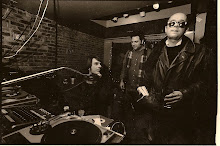

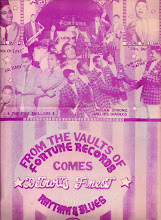
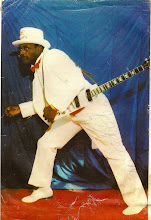

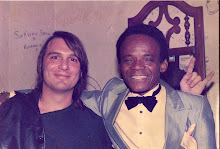
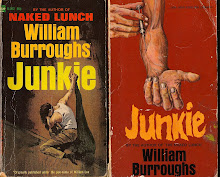




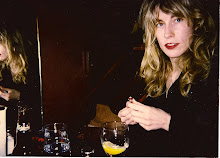
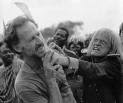

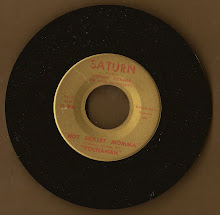
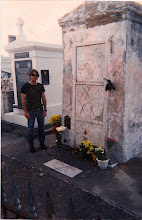


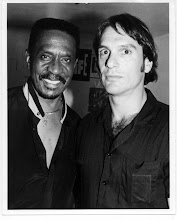
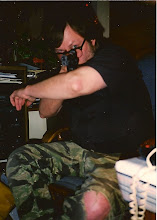
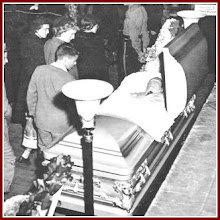
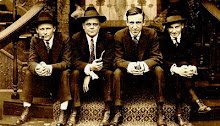
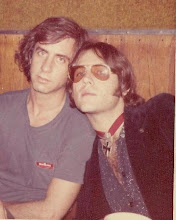b.jpg)





